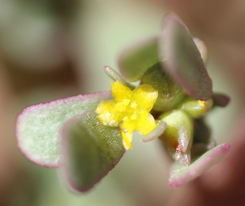
Location
On church wall (N35D33'00.107 X W105D41'21.227)
Flowers first observed: 9/12/17
Plant w/Flowers

Flower

Distribution
"It has an extensive distribution, assumed to be mostly anthropogenic,[2] throughout the Old World extending from North Africa and Southern Europe through the Middle East and the Indian Subcontinent to Malesia and Australasia. The species status in the New World is uncertain: in general, it is considered an exotic weed, however, there is evidence that the species was in Crawford Lake deposits (Ontario) in 1350-1539, suggesting that it reached North America in the pre-Columbian era. Scientists suggested that the plant was already eaten by native Americans, who spread its seeds. How it reached the New World is currently unknown.[3] It is naturalised elsewhere, and in some regions is considered an introduced weed." (Wikipedia)
"Found in open, disturbed locations, below 8,500 ft (2590 m); flowers June-October. Distribution: Cosmopolitan, on every continent in the world; throughout N. Amer. and in every state in the US." (SEINet)
Description
"Succulent annual herb from a short slender taproot and a few fibrous roots; stems prostrate or ascending, radiating out from the center of the plant to form a sprawling mat up to 60 cm wide; stems fleshy, glabrous, usually red. Leaves: Alternate or opposite along the stems; blades ovate to spoon-shaped, 3-30 mm long, succulent. Flowers: Solitary or in clusters of 2-5 at stem tips, each cluster of flowers subtended by a whorl of several leaves; sepals 2 per flower, fused at base, green or reddish; petals 5 per flower, yellow, 3-5 mm long. Fruits: Capsule ovoid to globose, 3-8 mm wide; splitting open so the top comes off like a pot lid (circumscissile) to release many tiny dark brown to black seeds, less than 1 mm long." (SEINet)
Ethnobotanical Uses
Food:
"The stems and leaves are edible raw or cooked, and are sold in grocery stores as purslane in the US and verdolagas in Latin America. The leaves have higher levels of omega-3 fatty acids and antioxidents than any other leafy green on the market, and the plant is fed to chickens to lower egg cholesterol." (SEINet)
"Acoma Vegetable Plants cooked with meat and eaten like spinach. Apache, Chiricahua & Mescalero Unspecified Eaten without preparation or cooked with green chile and eat or animal bones. Hopi Unspecified Cooked in a gravy. Iroquois Vegetable Cooked and seasoned with salt, pepper, or butter. Isleta Vegetable Plants oven dried, stored, and used as greens during the winter. ---" (Moerman 434)
"Although purslane is considered a weed in the United States, it may be eaten as a leaf vegetable.[6] It has a slightly sour and salty taste and is eaten throughout much of Europe, the Middle East, Asia, and Mexico.[1][7] The stems, leaves and flower buds are all edible. Purslane may be used fresh as a salad, stir-fried, or cooked as spinach is, and because of its mucilaginous quality it also is suitable for soups and stews. The sour taste is due to oxalic and malic acid, the latter of which is produced through the crassulacean acid metabolism (CAM) pathway that is seen in many xerophytes (plants living in dry conditions), and is at its highest when the plant is harvested in the early morning.[8]
Australian Aborigines use the seeds of purslane to make seedcakes. Greeks, who call it andrakla (αντράκλα) or glystrida(γλυστρίδα), use the leaves and the stems with feta cheese, tomato, onion, garlic, oregano, and olive oil. They add it in salads, boil it, or add it to casseroled chicken. In Turkey, besides being used in salads and in baked pastries, it is cooked as a vegetable similar to spinach, or is mixed with yogurt to form a tsatsiki variant[9]. Similarly, in Egypt, it is known as reglah رجلة and cooked as a vegetable stew. Called Bakleh in Syria and Lebanon, is eaten raw in a famous salad called fattoush, and cooked as a garniture in fatayeh (triangular salted pastries). In Albania, known as burdullak, it also is used as a vegetable similar to spinach, mostly simmered and served in olive oil dressing, or mixed with other ingredients as a filling for dough layers of byrek. In the south of Portugal (Alentejo), baldroegas are used as a soup ingredient. In Pakistan, it is known as qulfa and is cooked as in stews along with lentils, similarly to spinach, or in a mixed green stew." (Wikipedia)
Medicine:
"Cherokee Anthelmintic Compound decoction taken for worms. Ear Medicine Juice used for earache. Hawaiian Strengthener Plant and other plants pounded, squeezed, and resulting liquid taken to check run-down conditions. Iroquois Antidote Good medicine to cure you if someone has given you some bad medicine. Burn Dressing Poultice of mashed plant used on burns. Dermatological Aid Poultice of entire plant used on bruises. Keres, Western Antidiarrheal Infusion of leaf stems used for diarrhea. Blood Medicine Infusion of leaf stems used as an antiseptic wash for blood clots. Oral Aid Raw leaves rubbed in mouth for difficulty in opening the mouth. Navajo Analgesic Plant used for pain. Gastrointestinal Aid Plant taken for stomachaches. Panacea Plant used to 'cure sick people.' Rappahannock Dermatological Aid Compound decoction of bruised leaves applied as salve for 'footage' trouble." (Moerman 434)
"Known as Ma Chi Xian (pinyin: translates as "horse tooth amaranth") in traditional Chinese medicine.[citation needed] Its leaves are used for insect or snake bites on the skin,[10] boils, sores, pain from bee stings, bacillary dysentery, diarrhea, hemorrhoids, postpartum bleeding, and intestinal bleeding.[11]
Use is contraindicated during pregnancy and for those with cold and weak digestion.[11]" (Wikipedia)
Internet Links